What are the best rigs for Carp? As a Carp fishing guide (and all-around Carp fishing enthusiastic), this is, perhaps, the question I’m asked most frequently. (Besides, maybe, what is the best bait for Carp?)
Answering such a question demands consideration of so many variables that I couldn’t possibly narrow the selection down to one “ultimate” bait. Choosing one is impossible, but choosing a handful of favourites is a little easier.
So, let’s cut to the chase: Here are my top five rigs for Carp fishing!
(For simplicity’s sake, I’m assuming that readers are using a “semi-fixed bolt” weight set up like the one featured below.)
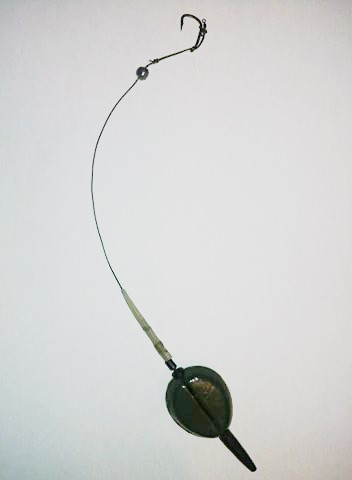
The Hair Rig (and Variations Thereof)
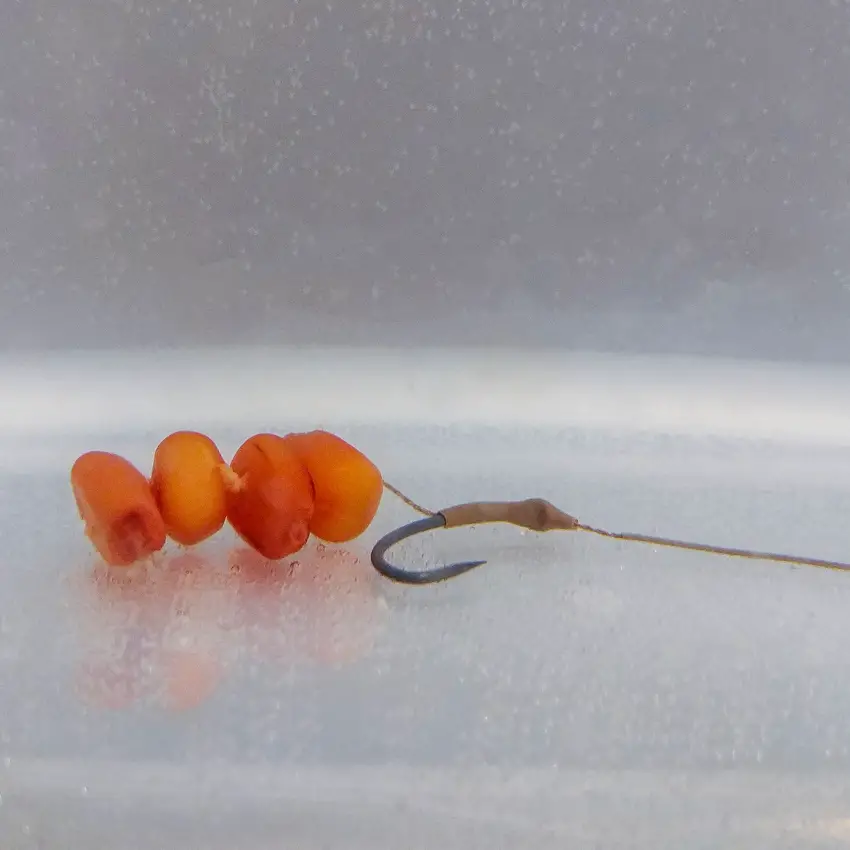
The Hair Rig is one of the most basic and commonly used rigs for Carp fishing. Its primary function is to separate the bait from the hook; this leaves the hook completely exposed. So, as the rig enters a Carp’s mouth, the hook can do so unimpeded by the bait, allowing for more predictable rig mechanics and, ultimately, greater hooking potential.
This method is a tried-and-tested classic. Kevin Maddocks and Len Middleton first introduced the hair rig in 1981 in the UK. Before this revolutionary concept, anglers commonly fished for Carp on prestigious British lakes with baited hooks—which had worked for a number of years.
But as the fish grew accustomed to angling pressure, they became increasingly tentative around rigs. In particular, they seemed to know when the bait was anchored to an angler’s line.
Carp anglers throughout the UK began working on new strategies to tackle these now-tricky fish. And thus, hair rigs were born—and indeed it worked!
Initially, the Hair Rig commonly consisted of a length of 1-2 lb monofilament line affixed to the hook’s shank with a whip-knot. Eventually, the easily tied knotless-knot method replaced the whip-knot as the standard. Since Maddocks and Middleton shared their incredible idea with the angling magazines in the ’80s, the Hair Rig can be found in almost every Carp angler’s rig wallet.
Hair Rig Variations
You may note that I added “and variations thereof” to the heading. This is because ever since the Hair Rig’s conception, numerous anglers have added their own touches and components to increase the hook-up potential.
Some of these components include shrink tubing (or hook aligners), split shots (or tungsten putty), a combination of hook-length materials (fluorocarbon/monofilament and braid), rig-rings—and the list goes on. Inevitably, these modifications of the hair rig earn their own names over time—like the “Blowback Rig” —but the concept still remains much the same.
The Hair Rig was indeed the first specifically designated Carp rigs that I tied and utilized. And to this day, I keep a few ready-tied in my rig wallet whenever I head for the bank.
I primarily use hair rigs when fishing maize/corn, a single boilie or a snowman rig (a combination of a pop-up bait coupled with a larger boilie affixed on the hair). I recommend using Hair Rigs when fishing a relatively clear bottom like flat rock, sand or dense silt.
Since the rig is meant to lay flat on the bottom, the hook should be free and clear of obstructions such as weeds and sticks on which one could easily snag. Additionally, gravel and silt can lead to the hook becoming lodged into the bottom, which inevitably leads to a dull or buried hook and, thus, a spoiled chance at a fish. Fishing over a solid bottom clear of debris is ideal for this classic rig. And it is a proven Carp catcher!
The Multi-Rig
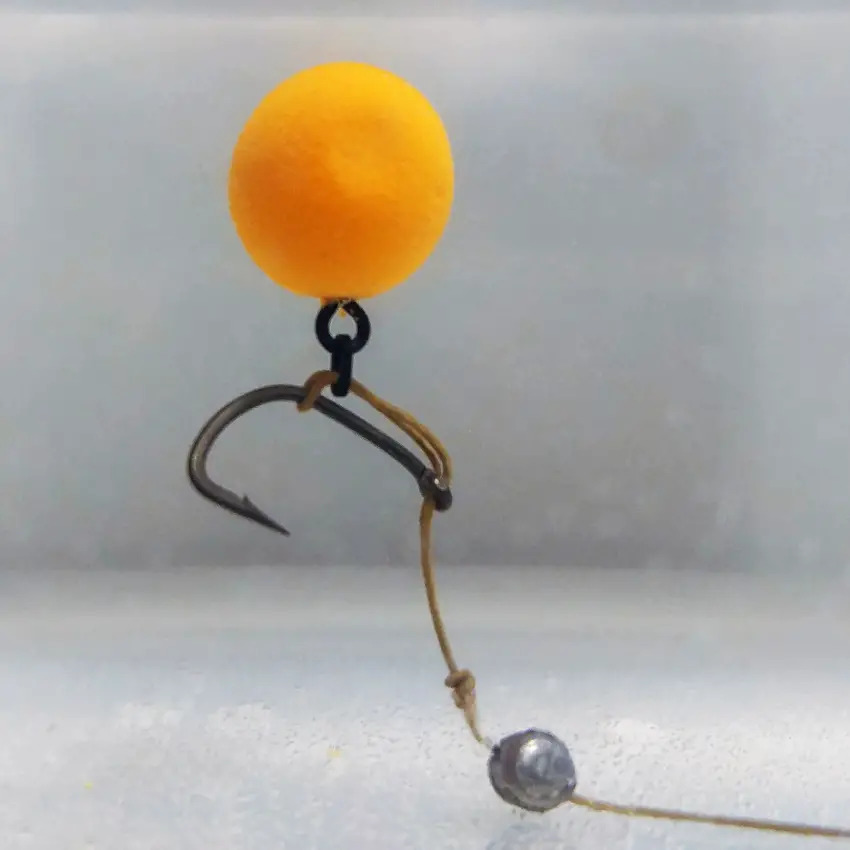
As Carp developed an ever more acute sensitivity to angling pressure throughout the 1980s, anglers had to think of new and innovative techniques—particularly on clear water beds where rigs are more visible. This prompted anglers to figure out ways to pursue Carp in more natural feeding areas. Specifically, over low-lying weeds and siltier bottoms. Thus was born the pop-up. The first pop-up baits were made using polystyrene (styrofoam) covered in a traditional boilie paste and microwaved.
Entirely Outside of the Box
These original pop-ups were later replaced with cork balls (far more eco-friendly) covered in boilie paste and prepared much the same way traditional boilies were, via boiling or steaming. The idea was to create a bait that would have a density less than that of water, allowing it to float. This revolutionary bait eventually led to the creation of commercial pop-ups utilizing cork dust or other buoyant compounds.
Inevitably, the pop-up created a need for new rigs to present these new buoyant baits. Since the late ’80s, Carp anglers around the world have adapted old rig concepts. Some have thought entirely outside of the box to create effective pop-up rigs.
The Multi-Rig was amongst these creations. And although its inventor and origin are unclear, its emergence was undoubtedly in the late ’90s or early 2000s. Most give credit to Mike Kavanaugh, as he was a recognized “Carp guru” and the first to write about the rig in magazines across the UK. However, others claim to have been the first to come up with the idea of using a modified sea-fishing rig known as the Sliding-Hook Rig.
Multi-Rig Over Time
Much like the Hair Rig, the Multi-Rig has undergone some massive changes over time. The modern Multi-Rig uses a loop-knot to affix the hook to the hook-link instead of a more static knotless-knot like the Palomar knot.
This loop is passed through the eye and around the hook, similar to passing a loop through a cleat to affix a bumper to a boat. In the event a fish picked up the rig, this loop would hold the hook securely.
On this loop, one would slide on either a rig-ring, micro swivel or bait-screw to attach the pop-up to the rig. Finishing off the rig with a split shot or a dab of tungsten putty just below the loop-knot ensures the rig sinks—except for the pop-up and hook.
One Brilliant Feature
This particular rig found its way into my top five because of one brilliant feature: The hook can be replaced quickly without having to retie. By simply reversing the process of putting the hook onto the loop, one can replace it if it gets dull, bent or broken. I tend to fish multi-rigs in all kinds of conditions as it offers a confident presentation over a variety of waters.
Additionally, they can be used as a bottom bait rig by merely replacing the pop-up with a boilie or maize/corn.
My only complaint with the multi-rig is the chance that the coated braid material used to tie it will begin to degrade over time, which increases the likelihood that the looped portion’s constitution will start to degrade. The mechanics of the rig will inevitably degrade, then, as well. However, being vigilant and always checking rigs before recasting usually prevents this problem.
The Multi-Rig is an essential tool for any Carp angler!
The Ronnie Rig/Spinner Rig
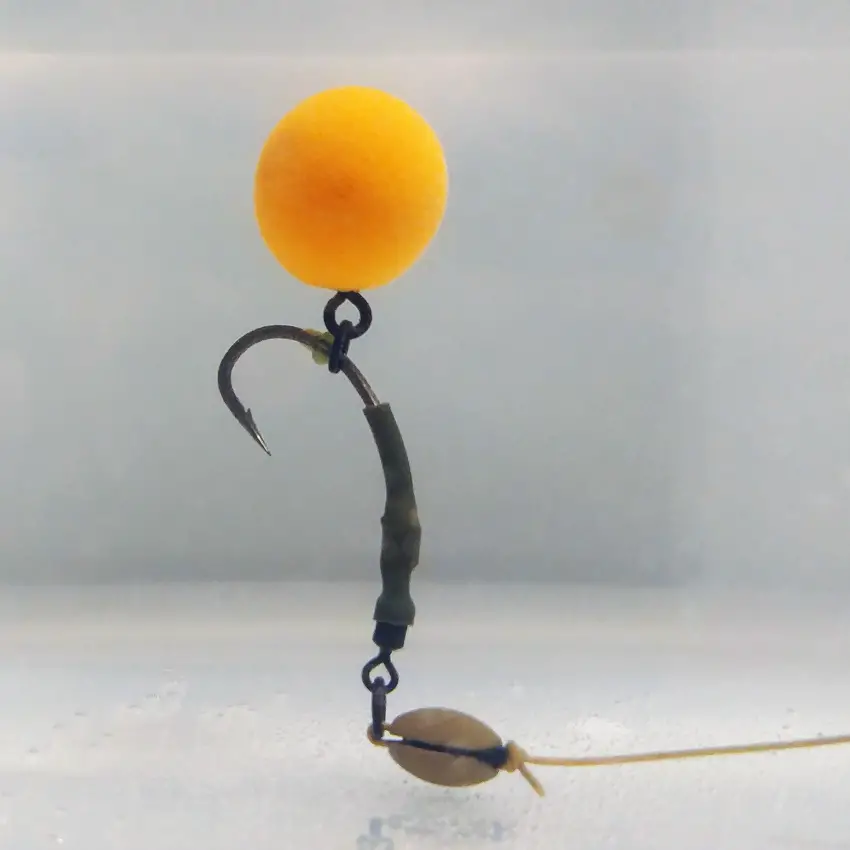
Now for a really bizarre concept: fishing without tying a hook to the line—not directly, at least. The Ronnie/Spinner Rig—along with the 360 Rigs—were all designed with one component separating the hook from the rig material: a swivel.
The 360 Rig, which predates the Ronnie/Spinner, utilized a standard barrel-swivel with an additional rig-ring. The hook passes through the one end of the barrel-swivel where it would stop at the hook-eye. A rubber hook-stop is used to stop the hook from falling off. A rig-ring or bait-screw slides onto the hook to attach the hook-bait, and then another hook-stop is added to prevent the bait from sliding off.
This rig proved to be incredibly effective on many waters throughout the UK and Europe. However, it was criticized for the amount of hardware and the potential for it to cause unnecessary damage to fish since it had a tendency to get stuck in angler’s landing-nets.
Ronnie: A Man of Mystery
I witnessed firsthand the tangled mess in my net-mesh and the damage done to a Carp’s mouth, resulting from it thrashing about after capture. Thus, the Ronnie/Spinner rig was born.
Now I bet you are wondering who Ronnie is. That, my friends, is a mystery! We do know that this Ronnie character is a friend of another respected angler, Martin Bowler.
Bowler revealed that Ronnie’s original idea for the rig differed a little from the one recognized today. We also know that the “cat was out of the bag,” so to speak, in 2016, when the rig began popping up in magazines and YouTube videos, and specialized tackle was manufactured for the Ronnie/Spinner Rig.
The Ronnie/Spinner Rig is usually tied using a quick-change swivel or specialized spinner rig swivel, which is affixed to the hook eye and then covered by shrink tubing or hook-aligner. This innovation makes for a tidier presentation with fewer chances of tangles in nets, making it a safer alternative to its predecessor.
Personal Experience with the Ronnie/Spinner Rig
I discovered Ronnie/Spinner Rigs approximately three years ago, just as they were emerging in the UK scene. I quickly began adding them to my arsenal and fished them a great deal for two seasons. They were especially effective when fished over gravel and dense silt, coupled with a pop-up of choice.
Additionally, one can utilize the Ronnie/Spinner Rig when fishing bottom baits, although it does get the name “Turbo German” (for reasons unknown to me) once the bait sits on the bottom. Whether popped up or on the bottom, I have had a great deal of success with this rig, and it has caught me some genuinely remarkable fish.
I did, however, experience a few issues. My Carp sensei, Phil Tabry, summarized one such issue well. In his words, “They [Ronnie/Spinner Rigs] present consistently, but land randomly.” I think this is the biggest concern I have heard about this rig; the Ronnie/Spinner Rig will indeed turn indefinitely, which means that no matter what angle a Carp approaches that bait, it is sure to turn towards them. This may sound great in theory, but in practice can result in some awkward hook-holds.
The Unpredictability Factor
Typically, one wants to have a Carp securely hooked in the bottom lip, dead centre of the mouth. Or—second best—in a corner where the flesh is concentrated. Unfortunately, though I’ve landed a ton of Carp on these rigs, I did find that my rig was awkwardly hooked on occasion. Sometimes even in the roof of the mouth. Or, worse yet, outside the mouth altogether. This unpredictability dampens the reputation of the Ronnie/Spinner Rig.
The only other concern I have with the Ronnie/Spinner is that the additional hardware means increased chances of something going wrong. I did note on one or two of my sessions that, when my rig landed in softer silt where the swivel was partially buried, silt could find its way into the barrel of the swivel, impeding its movement.
Overall, I can’t knock Ronnie/Spinner Rigs too much. After all, the overwhelming majority of the Carp I landed were indeed hooked in a desirable way.
The Withy Pool Rig
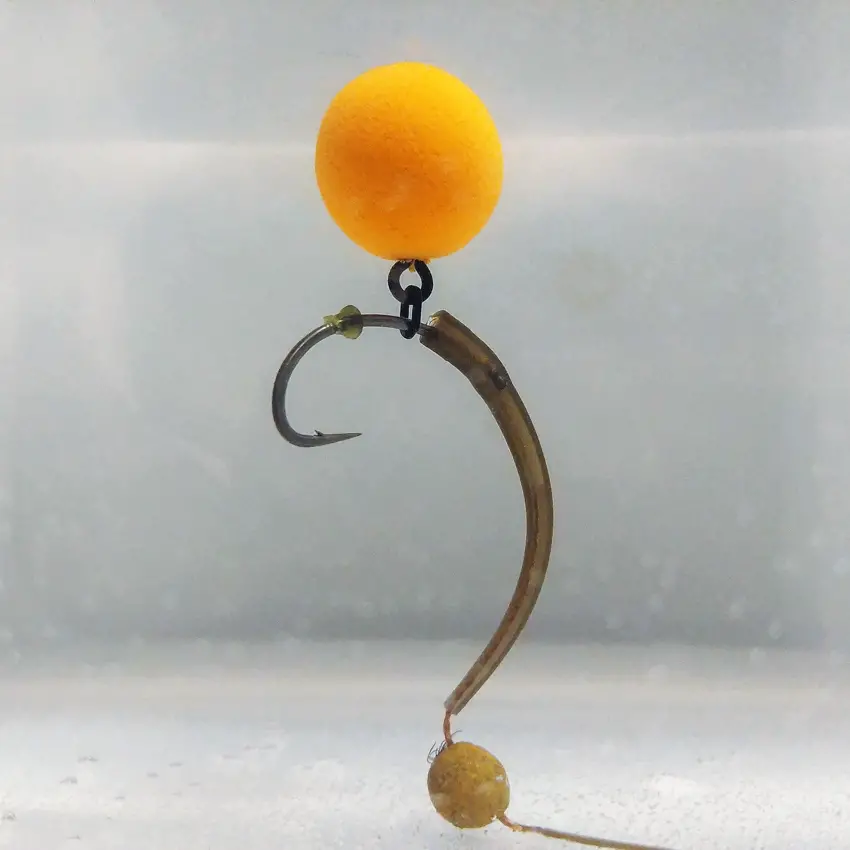
British fishing icon Steve Reynard invented this brilliant rig over thirty years ago.
The concept is simple: a rig that is almost impossible to eject once its in a fish’s mouth. Withy Pool was the name of rather tricky water in Bedfordshire, UK. Raynard was challenged with trying to determine a way to trip up some incredibly wary fish. The Withy Pool Rig was the product of many nights of strenuous thought.
The rig is simple and is considered by many to be one of the best, if not THE best pop-up rig ever conceived. Reynard’s concept proved to be effective, landing him some of the most elusive specimens in the lake.
The rig is tied using a stripped back-length of semi-stiff coated braid, a curve-shank hook, a length of shrink tubing, bait-screw or rig-ring, a hook-stop, and a split-shot or dab of tungsten putty. The hook is tied to the coated braid using one’s preferred knot. Then, the shrink tubing is cut to fit just over the hook’s eye to the break in the braid’s coating.
The shrink tubing is then heated using a kettle. While it’s still hot and malleable, it’s formed into a “C” shape (the aggression of the bend is up to the angler, but it is important to be mindful to not close the gap too tightly). Once the shrink tubing cools, it will retain this shape, making for a highly responsive rig (more on this in a moment).
Finish it off with the bait-screw or rig-ring, hook-stop, and your chosen split shot or tungsten putty to offset the buoyancy of the bait, and you have a proven Carp-catcher.
A Highly Responsive Rig
What did I mean by responsive? Upon attaching a pop-up to that rig and submerging it, the answer should become clear: This rig will turn in any direction from which a Carp could pick it up. And once in its mouth, it has a near one-hundred percent hook-up ratio.
The Withy Pool has only really been a part of my arsenal for the past year, so my experience is limited, but I have played with it. Before using the Withy Pool, I was a big fan of the Hinged Stiff Rig, which is mechanically similar. Both of these rigs function with the same concept—that a longer, stiffer material attached to the hook mimics the hooking properties of a long-shank hook, without needing to add additional weight.
The Withy Pool Rig makes its way into my top five favourites for this reason: it is made using a single length of braid (rather than a braid and fluorocarbon combination). Though many would argue that a well-tied Hinged Stiff rig is just as effective as a Withy Pool, the fact remains that the more knots and components present, the higher the potential for rig failure.
The Withy Pool took priority in my angling last year, catching me the majority of my fish in almost every condition imaginable: gravel, low-lying weeds, silt, and decayed leaf matter. In fact, with the possible exception of incredibly dense, deep weed mats, the Withy Pool can be fished anywhere. I highly recommend this rig. Seriously—get tying!
The Shotshank Rig
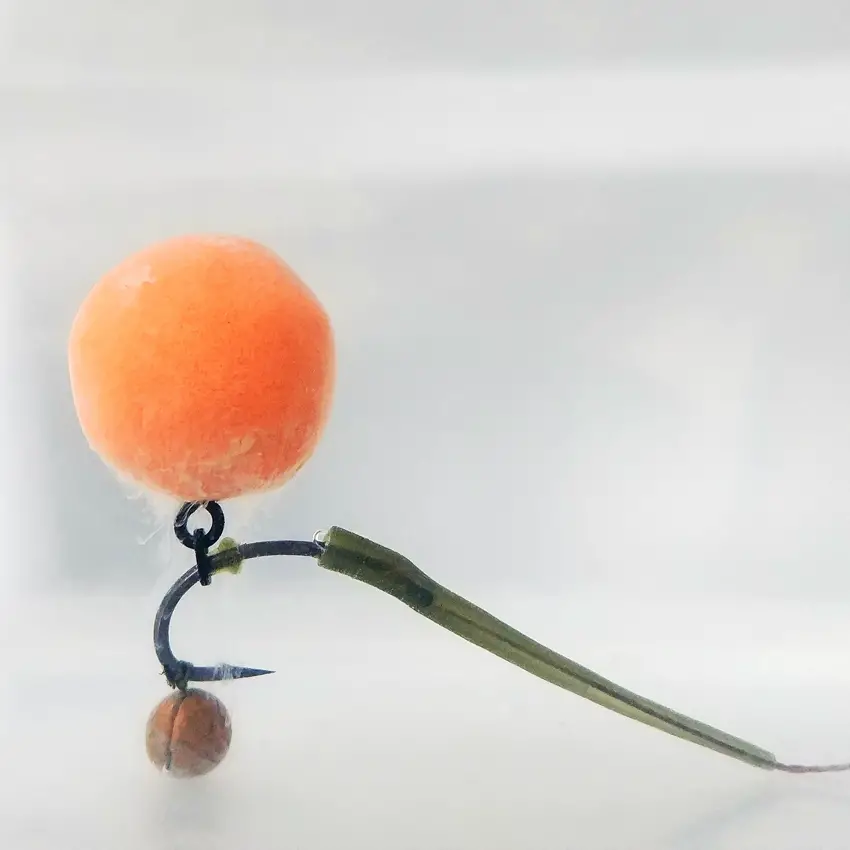
Those of you that know me personally will know that I often boast about the Spotshank Rig. The concept isn’t original but is, in fact, a combination of two ideas—which I am proud to say I combined.
The first (and most obvious) concept is the presence of a split-shot affixed to a tiny piece of braid, which is then fastened in place by burning and blobbing the braid with a lighter. This rig, initially created by Frank Warwick, is known as the Shot-on-the-Hook Rig (which doesn’t exactly roll off the tongue).
Carp Vacuum
One must imagine that a Carp creates a vacuum when taking the bait or rig into their mouth. Once this vacuum-like atmosphere neutralizes, the rig drops as though it were falling through the water column again. So the rig will drop onto the bottom of a Carp’s mouth. The Shot-on-the-Hook Rig utilizes a heavier hook-point; the idea is when a Carp sucks in the rig, and the rig enters ‘free-fall’, the hook will be driven down by the weight and thus have excellent hooking potential.
A concern raised about this rig is the possibility of the split-shot impeding the hook’s ability to penetrate deep. However, those who have tried spooling a stainless steel spool with braid will know that braid slips on steel and requires a backing to prevent this. The same principle applies here: The split-shot will move up and out of the way if the hook points find a home—meaning the hooking potential of this rig is incredible.
When I first started experimenting with this rig, I found it tended to tangle on the cast. This was probably because the added weight on the hook exceeded the coated braid hook link’s stiffness. So, while descending to the bottom, there was a chance that the rig would collapse upon itself and potentially tangle or sit in an undesirable manner.
Kill Two Birds With One Stone
This led me to introduce a second concept that would essentially kill two birds with one stone: I would introduce the mechanics from Scott Lloyd’s Noodle Rig by adding a shrink tubing or longer hook-aligner to better balance the presentation. This forces the rig to kick out more effectively while increasing the hooking potential. The result is a more cumbersome rig to try and eject. Needless to say, this rig is an excellent feat of ingenuity.
Though I have not used this rig as shown in the photo, I have used both the Noodle Rig and the Shot-on-the-Hook Rig, and feel that the union of these two concepts will only mean the best of both worlds. The Shot-on-the-Hook Rig (and slight variations thereof) landed me a few fish last year and proved to have deep, sure hook-holds.
The Noodle Rig is essentially a Hair Rig variation with a notably longer hook-aligner, which I have experimented with in the past with great success. My Shotshank Rig was conceived during this past winter and has yet to see action. So you may be wondering why it has made the list. Well, in my studying of rig-mechanics, this rig checks off most—if not all—of the boxes.
I believe this rig will perform in practice as well as it does in theory. I recommend fishing this rig over clearer bottoms, dense silt, and anywhere you may fish a Ronnie/Spinner Rig.
Parting Words

It is important when choosing a rig to be mindful of the water you’re fishing; some rigs work better in different applications. With practice and experience, it becomes easier to choose the right rig for the water. I also recommend that you consider the stock of fish you are pursuing.
If you have a large population of big fish or are fishing in particularly snaggy or zebra-mussely waters, consider using more robust materials in twenty-plus-pound breaking strain.
While on the topic of rig materials, consider purchasing coated braid; this is ideal for tying coarse fishing rigs, and you will have a great deal more confidence that your rigs are presented as intended.
When I used to tie Hair Rigs using the same braid I would spool my reels with, I found that my rigs were far more likely to tangle. Once I switched to coated braids, I discovered that this problem was alleviated. The rigs both presented better and caught more Carp.
Final Advice
A few final pieces of advice: Go with what you feel confident in; there’s no point in using a rig with which you have no confidence. So practice tying a variety of rigs so you can be sure your presentation is as intended.
Additionally, don’t be afraid to try new waters, even if they might be weedy! Here in North America, our Carp see little angling pressure, and some might even call them a bit naive; so you’ll often find yourself using simple rigs on clear lake/river beds without a problem. But it’s always important to try new things and explore new areas. We are truly fortunate to have the opportunity to target such hard-fighting fish here in Ontario.
So get out there, try out some of these Carp rigs, and make the most of this exciting species!
Tight Lines





